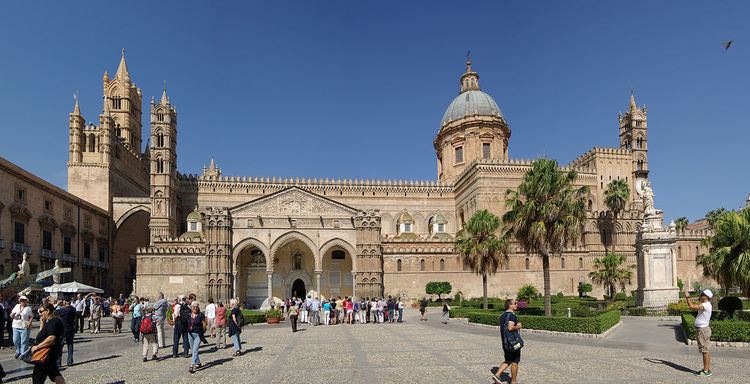Established 1st Century Phone +39 091 607 7111 | Parishes 178 Area 1,366 km² | |
 | ||
Population- Total- Catholics (as of 2013)912,800 (est.)905,700 (est.) (99.2%) Address Via Matteo Bonello, 2, 90134 Palermo, Italy Similar Chiesa di Sant'Ago, Seminario Arcivesco di Palerm, Parrocchia S Giuseppe, Museo Diocesano di Palermo, Azione Cattolica Italiana | ||
The Roman Catholic Metropolitan Archdiocese of Palermo (Latin: Archidioecesis Panormitana) was founded as the Diocese of Palermo in the first century and raised to the status of archdiocese in the 11th century. The Archbishop of Palermo is Corrado Lorefice.
Contents
- History
- Arab control over Palermo and its church
- Norman control over the church of Palermo
- Reference Works
- Studies
- References
The archdiocese has the following suffragans in the ecclesiastical Province of Palermo:
History
Palermo is just south of a major active seismic zone, and is subject to frequent earthquakes and occasional inundations (tsunamis). The events of 1693, 1726 and 1823 were particularly destructive.
Pope Gregory I personally founded six monasteries in Sicily, including the monstery of S. Hermes at Palermo, according to Ugo Benigni in his article on Sicily in the Catholic Encyclopedia. He also founded the monastery of S. Hadrian and the Praetoritanum. Ugo Benigni attributes this interest to the numbers of bishops and monks who emigrated from Africa as a result of the policy of the Arian Vandals to the Orthodox Christians.
In 718 the Emperor Leo III the Isaurian (718–741) suppressed a revolt in Sicily, and then detached southern Italy and Sicily from the metropolitan jurisdiction of the Pope in Rome. In the ninth century, the Patriarch of Constantinople raised the See of Palermo to the rank of Metropolitan of all of Sicily. A protest against these actions was entered by Pope Nicholas I (858–867), in a letter of 25 September 860 to the Emperor Michael III.
Arab control over Palermo and its church
Benigni states, "Concerning the state of the Sicilian Church during the Saracen domination we have no information: not the name of a single bishop is known." This is misleading. There were bishops, but they were part of the Patriarchate of Constantinople, not that of Rome, and Constantinople was in communion with Rome until the Great Schism of 1054. In 883, Pope Marinus I paid a ransom to the Emir of Palermo for the Archbishop of Syracuse and the bishop of Malta, who were being held in prison in Palermo. In 897, the Archbishop of Palermo was Sofronios (or Sonfronius). In 930, there was a seminary in operation under the direction of the Archbishop of Palermo; when Eustatius was about to pay the 12,000 'krus' per annum which was owed, the Collector, who noticed the extreme poverty of the students, gave part of the funds to the Archbishop for the benefit of the seminary. In 957 an Archbishop named Arimattea was already occupying the See; in 964, Archbishop Arimattea was abused and imprisoned by the Grand Mufti of Palermo, from which he died. In 965, the Archbishop of Palermo was Andreas, who had been Vicar of Archbishop Arimattea. In 976, according to Arabic sources, the Archbishop of Palermo died, and the priests and monks elected a new Archbishop named Ananiah, who had been Vicar of his predecessor. The Patriarch of Constantinople (Anthony the Studite) was requested by an embassy from Palermo to approve the election, which he did, expressing the wish that the Archbishop-elect should come to Constantinople and be consecrated by him. The Emperor did not approve of these patriarchal pretensions, and the Patriarch renounced them. The priests and monks told the Emir of Sicily that the custom had been for the bishops of Sicily to consecrate the Archbishop. They asked permission to write to the Pope, which was refused.
Arab invasions of Sicily had begun at the beginning of the eighth century with the capture of the island of Cossura (modern Pantelleria). Raids were launched in 730–731, 734–735, 740 and 752–753. Palermo was temporarily captured in 820, but the Arabs were driven out by pirates. The serious conquest of the island began in 827, from the Tunisian port of Susa, led by Asad Ibn Al-Furàt. Palermo fell in 831, Messina in 843, Leontini in 847, and Syracuse in 878. Taormina was captured in 902, completing the conquest of the entire island. From then until 1061, when the Norman conquests, began Sicily was an Arab land.
After the famine of 940, the Arabs deliberately drove Christians out of the western part of the island.
Norman control over the church of Palermo
On Christmas Day, 1130, Count Roger II was crowned King of Sicily in the Cathedral in Palermo. It is uncertain who crowned the king. One source names Count Roger of Capua, another Archbishop Peter of Palermo. The Cathedral was rebuilt by Archbishop Walter between 1170 and 1190.
The Archdiocese of Palermo was united with the Archdiocese of Monreale on 7 July 1775. The union was dissolved on 12 March 1802. Monreale lost its metropolitan status in 2000, however, and it is now a suffragan of the Archdiocese of Palermo.
The Cathedral of Palermo is dedicated to the Bodily Assumption of the Virgin Mary into Heaven. The Chapter of the Cathedral had three dignities in 1677, and two dignities in 1775. In 1211 there were eighteen Canons, but the number grew to twenty-four in 1431, when Pope Eugenius IV ordered their reduction to eighteen again. In 1523 the Emperor Charles V added six more Canons, bringing the number back up to twenty-four. There were again twenty-four Canons in 1677 and twenty-six Canons in 1775. The Chapter had the right to elect the Archbishop.
